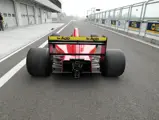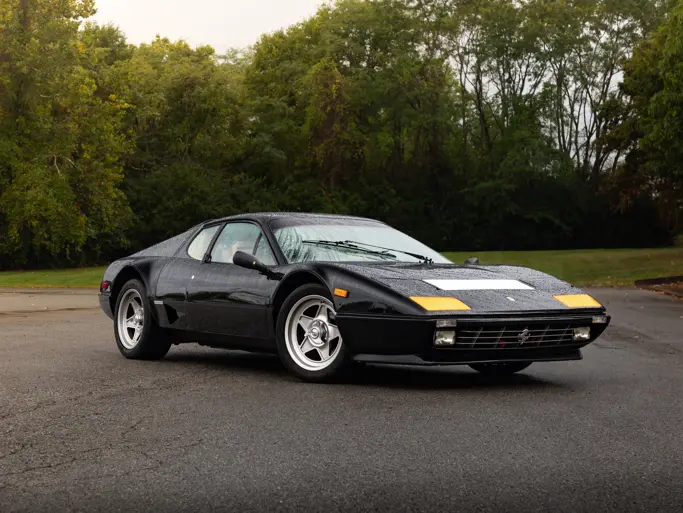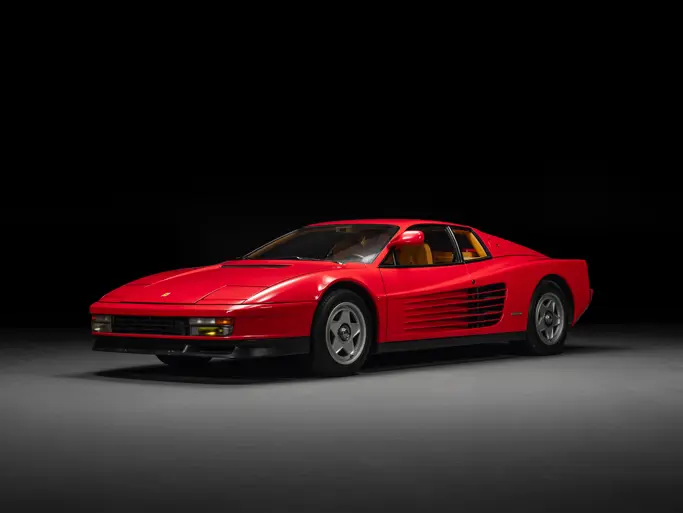
1989 Ferrari F1-89 Formula One
{{lr.item.text}}
€616,000 EUR | Sold
{{bidding.lot.reserveStatusFormatted}}
- John Barnard’s first F1 design for Ferrari
- The first seven-speed semi-automatic F1 gearbox with paddle shifters
- Raced in period by Gerhard Berger
- The first Ferrari driven by Alain Prost after leaving McLaren
- Fully restored by Ferrari F1 Clienti and tested at Mugello; Classiche certified
- Première Formule 1 conçue par John Barnard pour Ferrari
- Première boîte F1 semi-automatique sept rapports à palettes
- Utilisée à l'époque par Gerhard Berger
- Première Ferrari pilotée par Alain Prost après avoir quitté McLaren
- Complètement restaurée par Ferrari F1 Clienti et essayée au Mugello ; certificat Ferrari Classiche
600 hp, 3,497 cc DOHC V-12 fuel injection, seven-speed semi-automatic gearbox, independent front and rear suspension with double wishbones and push rods, and four-wheel carbon-fibre disc brakes. Wheelbase: 2,829 mm
Moteur V-12, 3 497 cm3, 600 ch, 2 ACT par banc, alimentation par injection, boîte semi-automatique sept rapports, quatre roues indépendantes par doubles triangles inégaux et balanciers, freins à disques en fibre de carbone sur les quatre roues. Empattement: 2 829 mm.
British designer John Barnard was given virtual carte blanche to restore Ferrari’s Formula One fortunes to the top rank when he agreed, in 1987, to an enormous salary and the opportunity to establish a new Ferrari Technical Centre in England.
Ferrari had not won a Formula One race since the German Grand Prix in 1985, after breaking Renault’s grip on turbo-F1 racing with consecutive World Championships for constructors in 1982 and 1983 with a 1.5-litre V-6 engine. Nonetheless, the selection of an Englishman to head Ferrari’s F1 technical development was controversial all around.
Amongst Barnard’s previous accomplishments was the Chaparral 2K Indy Car designed for Jim Hall; this was the car that won the 1980 Indianapolis 500 whilst being driven by Johnny Rutherford. This success quickly brought Barnard to the new McLaren team, where he worked on the McLaren MP4/1, the first carbon-fibre composite (FCC) chassis in Formula One.
During Barnard’s tenure, McLaren became the dominant force in Formula One, with Niki Lauda and Alain Prost winning the Drivers’ Championship in 1984, 1985, and 1986. McLaren also won the Constructors’ Championship in 1984 and 1985, narrowly losing a third consecutive championship to Williams in 1986.
Ferrari’s F1 design for 1987 and 1988 had already been set down by the time Barnard joined Ferrari, so he began work on an all-new car, the F1-89, which would be Ferrari’s first entry for the new non-turbo rules beginning in 1989.
Barnard’s decision to base his technical centre in England was not popular with the F1 team located in Italy. Barnard also introduced his own methods into Ferrari, which have been described as “a maniacal analysis of every single detail” of previous practice.
One Ferrari innovation that Barnard did bring forward with the new car was the revolutionary seven-speed semi-automatic gearbox that was operated by paddles located on the steering wheel. This design was originally created at Ferrari in 1979 by Mauro Forghieri, but development stalled because the advanced electronics needed to perfect the system were not yet available.
According to journalist Quentin Spurring, who followed F1 closely in the era, Barnard’s F1/89 was equipped with a range of technical innovations, with the most significant of which being the gearshift that was described as an “electro-hydraulic” mechanism. The paddles are electronically controlled by hydraulic actuators in the semi-automatic gearbox with solenoids.
Drivers used the clutch pedal only to start. Ratios in the seven-speed gearbox were shifted throughout the race by squeezing paddles on the back of the steering wheel, with the right paddle for upshifts and the left for downshifts. This innovation became universal throughout Formula One racing within five years, and today, it is common on high-performance road cars.
The Ferrari engine for the new 3.5-litre naturally aspirated formula was a lightweight 65-degree V-12 designed by Claudio Lombardi. The engine utilised five valves per cylinder (three intake) and two overhead camshafts per cylinder bank, which were driven off the front of the engine. Fuel was delivered through Weber-Marelli digital electronic injection, and the ignition was a Magneti Marelli electronic one with one plug per cylinder. Maximum power was rated at 600 horsepower at 12,500 rpm.
The engine and semi-automatic gearbox were mounted in a single-piece monocoque made of carbon fibre and Kevlar honeycomb, with detachable composite bodywork. The front suspension was by double-elliptic section wishbones and push rods. Similarly, the rear suspension was also by double wishbones and push rods. Steering was by rack and pinion, and the brakes utilised ventilated carbon-fibre discs and one-piece Brembo callipers on all four wheels.
The Ferrari F1/89 was rated highly as the 1989 F1 season began. Ferrari had extensively tested two V-12 non-turbo cars throughout the second half of 1988 and hoped to take the fight to McLaren and Honda from the first race of 1989.
Ferrari’s Gerhard Berger had been the only driver to take a race from McLaren-Honda in the remarkable 1988 season, which saw McLaren win 15 of 16 F1 races with drivers Ayrton Senna (8) and Alain Prost (7). Berger’s teammate at Ferrari for 1989 was future world champion Nigel Mansel.
Both Berger and Mansell took to the F1/89 immediately. Incredibly, Mansell won in his first start for Ferrari and the first race of the season in Brazil, endearing himself to Ferrari fans. Ferrari, however, found almost as quickly that 600 horsepower was not enough to challenge the new McLaren-Honda V-10 on a regular basis, and they found themselves chasing power throughout the year.
The complexity of the new F1/89, and particularly the semi-automatic gearbox, also led to a disappointing string of retirements throughout the season. Mansell did manage to score a 2nd in France and Britain and 3rd in Germany and Belgium, with Berger taking a long-awaited victory in Portugal, together with a 2nd in Italy and Spain. McLaren won 10 of 16 races in 1989, including the Drivers’ and Constructors’ Championships. Ferrari was the best of the rest.
This 1989 Ferrari F1/89 Formula One car is chassis 110, and it was driven during the 1989 F1 season by Gerhard Berger in the Mexican, U.S., Canadian, French, British, and German Prand Prix. Berger started 4th on the grid at Canada, Great Britain, and Germany, but his races were plagued with the same reliability issues that affected the F1/89 throughout the season.
Alain Prost won his third World Drivers’ Championship with McLaren in 1989 and then promptly departed to Ferrari, where he was reunited with John Barnard. This F1/89, chassis 110, was the first Ferrari F1 car tested by Prost upon his arrival at Ferrari.
As presented, this F1/89 is an important piece of Ferrari history and Formula One technical evolution history. It represents the golden era of Formula One, the Prost-Senna contest, the naturally aspirated big capacity V-12 engines, and the sexy “Coca Cola bottle” design. It has recently been fully sorted by Ferrari F1 Clienti and has been shaken down for 150 kilometres at Mugello. It has been Ferrari Classiche certified and is ready for the right new owner and driver to return it to all F1 Historic races.
L'ingénieur britannique John Barnard a reçu pratiquement carte blanche pour que Ferrari retrouve en Formule 1 le niveau le plus élevé quand il a accepté, en 1987, moyennant un énorme salaire, d'établir en Angleterre un nouveau Centre Technique Ferrari.
Ferrari n'avait pas remporté de course de Formule 1 depuis le Grand Prix d'Allemagne 1985, après avoir mis un terme à la domination des Renault turbo et avoir remporté le Championnat du Monde des Constructeurs en 1982 et 1983 avec un moteur V-6 de 1,5 litre. Quoi qu'il en soit, l'engagement de l'ingénieur anglais pour diriger le développement technique des Ferrari de Formule 1 provoquait une certaine polémique.
Parmi ses réalisations, Barnard comptait la Chaparral 2K Indy conçue pour Jim Hall ; c'est la voiture qui avait reporté les 500 Miles d'Indianapolis 1980, entre les mains de Johnny Rutherford. Ce succès amenait Barnard dans l'équipe McLaren, où il travaillait alors sur la McLaren MP4/1, premier châssis de Formule 1 en fibre de carbone (FCC).
Pendant la période Barnard, McLaren est devenue une équipe dominante en Formule 1, Niki Lauda et Alain Prost remportant le championnat pilotes en 1984, 1985 et 1986. McLaren s'adjugeait aussi le championnat constructeurs en 1984 et 1985, manquant de peu une troisième couronne consécutive en 1986.
La conception des monoplaces Ferrari F1 pour 1987 et 1988 avait été déjà déterminé quand Barnard est arrivé chez Ferrari, si bien qu'il commençait à travailler sur une toute nouvelle voiture, la F1-89, qui serait la première Ferrari de la nouvelle formule sans turbo, à partir de 1989.
Le décision de Barnard de baser le centre technique en Angleterre n'a pas été très bien acceptée par l'équipe F1 située en Italie. Barnard introduisait aussi chez Ferrari de nouvelles méthodes, décrites comme « une analyse maniaque de chaque détail », méthode gagnée de ses expériences précédentes.
Une des innovation apportées par Barnard sur cette nouvelle voiture était la boîte F1 semi-automatique sept rapports révolutionnaire, commandée par des palettes au volant. Ce design avait été créé par Ferrari en 1979 par Mauro Forghieri, mais le développement avait été stoppé par manque d'un système électronique suffisamment avancé et fiable.
Selon le journaliste Quentin Spurring, qui suivait de près la F1 à cette époque, la F1/89 de Barnard était équipée de plusieurs innovations techniques, la plus significative étant le changement de vitesses décrit comme un mécanisme « électro-hydraulique ». Les palettes étaient contrôlées électriquement par des déclencheurs hydrauliques, avec des solénoïdes, dans la boîte semi-automatique.
Les pilotes n'utilisaient l'embrayage qu'au départ. Les sept rapports de la boîte étaient commandés en appuyant sur les palettes placées derrière le volant, celle de droite pour monter les vitesses et celle de gauche pour les descendre. Cette innovation est devenue universelle en Formule 1 en l'espace de cinq ans et, aujourd’hui, elle est répandue également sur les voitures de route de performances élevées.
Le moteur Ferrai correspondant à la nouvelle règlementation 3,5 litres était un léger V-12 à 65° atmosphérique conçu par Claudio Lombardi. Il était muni de cinq soupapes par cylindre (dont trois pour l'admission), avec deux arbres à cames en tête par banc de cylindres, dont la commande était placée à l'avant du moteur. L'alimentation était confiée à une injection électronique Magneti Marelli, avec un simple allumage. La puissance maximum atteignait 600 ch à 12 500 tr/mn.
Le moteur et la boîte semi-automatique étaient installés dans une monocoque fabriquée en fibre de carbone et en nids d'abeille en Kevlar, avec une carrosserie composite démontable. La suspension avant était composée de triangles de section double-elliptique et de balanciers. De même, la suspension arrière comportait des doubles triangles et des balanciers. La direction était à crémaillère et les freins comportaient des disques en fibre de carbone et des étriers Brembo sur les quatre roues.
La Ferrari F1/89 faisait partie des favorites au début de la saison 1989. Ferrari avait effectué de nombreux tests sur deux V-12 atmosphérique dans la deuxième moitié de 1988, en espérant se battre avec McLaren et Honda dès la première épreuve de 1989.
Chez Ferrari, Gerhard Berger avait été en 1988 le seul pilote à remporter une victoire devant McLaren-Honda, qui avait monopolisé 15 des 16 courses de la saison avec Ayrton Senna (8) et Alain Prost (7). Pour 1989, le coéquipier de Berger était le futur Champion du Monde Nigel Mansel.
Berger et Mansell ont immédiatement pris en main la F1/89. Chose incroyable, Mansell remportait sa première course pour Ferrari dès le premier Grand Prix de la saison, au Brésil, s'attirant la passion des fans de Ferrari. Mais la marque au cheval cabré constatait rapidement que 600 ch ne suffisaient pas pour rivaliser de façon régulière avec la nouvelle McLaren-Honda V10, et passait la saison à courir après la puissance.
La complexité de la nouvelle F1/89, et particulièrement sa boîte semi-automatique, provoquait une série d'abandons décevants tout au long de la saison. Mansell signait tout de même une deuxième place en France et en Angleterre, et une troisième en Allemagne et en Belgique, Berger décrochant enfin une victoire au Portugal, ainsi qu'une deuxième place en Espagne. McLaren remportait la victoire dans 10 des 16 épreuves de 1989, ainsi que les titres conducteurs et constructeurs au championnat. Derrière, Ferrari était en tête des autres écuries.
La monoplace Ferrari F1/89 de 1989 proposée ici est le châssis 110, utilisé au cours de la saison de Formule 1 1989 par Gerhard Berger aux Grand Prix du Mexique, des États-Unis, du Canada, de France, d'Angleterre et d'Allemagne. Berger signait le quatrième temps aux essais au Canada, en Angleterre et en Allemagne, mais ses courses souffraient des mêmes problèmes de fiabilité qui affectaient la F1/89 tout au long de la saison.
Alain Prost remportait son troisième titre de Champion du Monde de Formule 1 avec McLaren en 1989 et passait rapidement chez Ferrai, où il retrouvait John Barnard. Cette F1/89, châssis 110, fut la première Ferrari testée par Prost lors de son arrivée chez Ferrari.
Dans sa présentation, cette F1/89 est un pièce importante de l'histoire de Ferrari et de celle de l'évolution technique de la Formule 1. Elle représente l'âge d'or de la Formule 1, la rivalité Prost-Senna, les gros V-12 atmosphériques et la forme séduisante en « bouteille de Coca Cola ». Cette voiture a été complètement révisée récemment par Ferrari F1 Clienti et a été rôdée sur 150 km sur le circuit du Mugello. Elle a reçu un certificat de Ferrari Classiche et elle est prête à ce que son nouveau propriétaire et pilote l'engage à nouveau en courses de Formule 1 historiques.

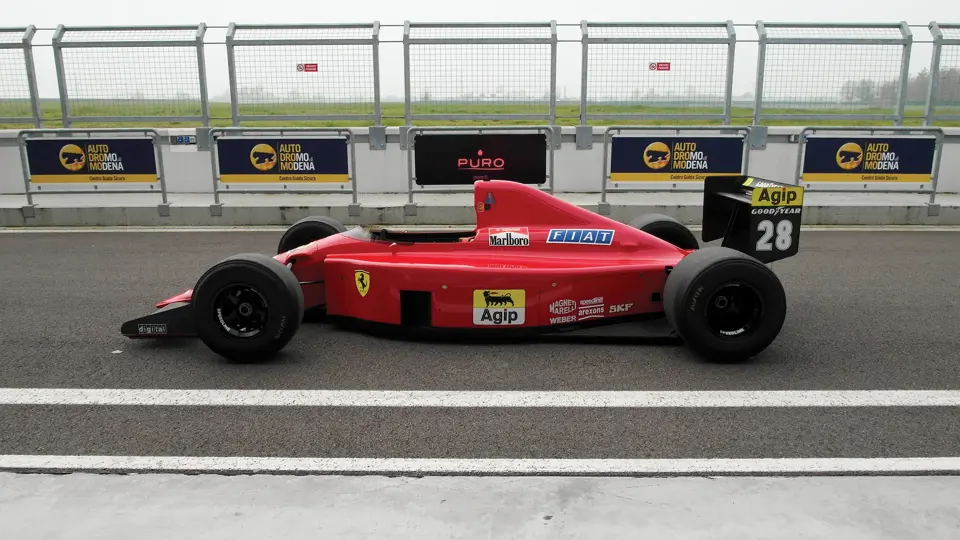
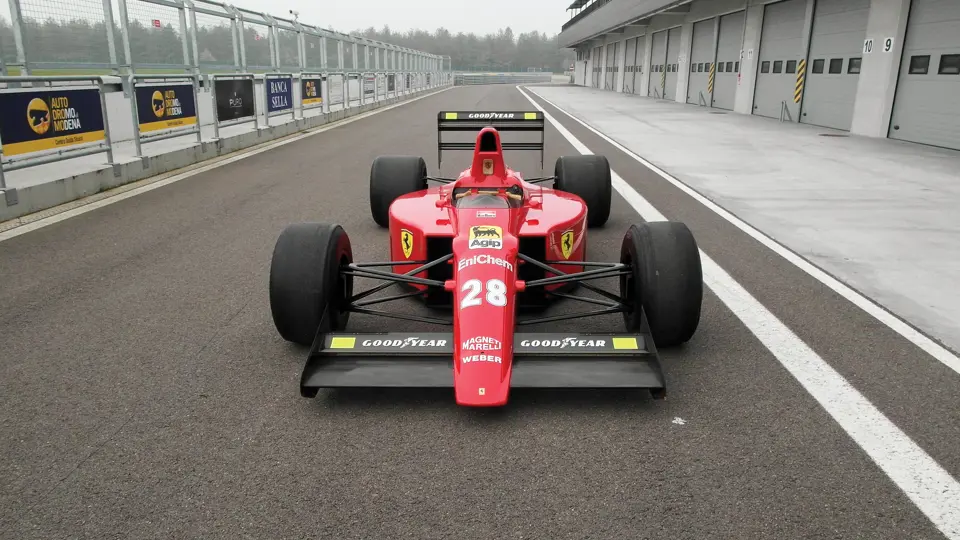




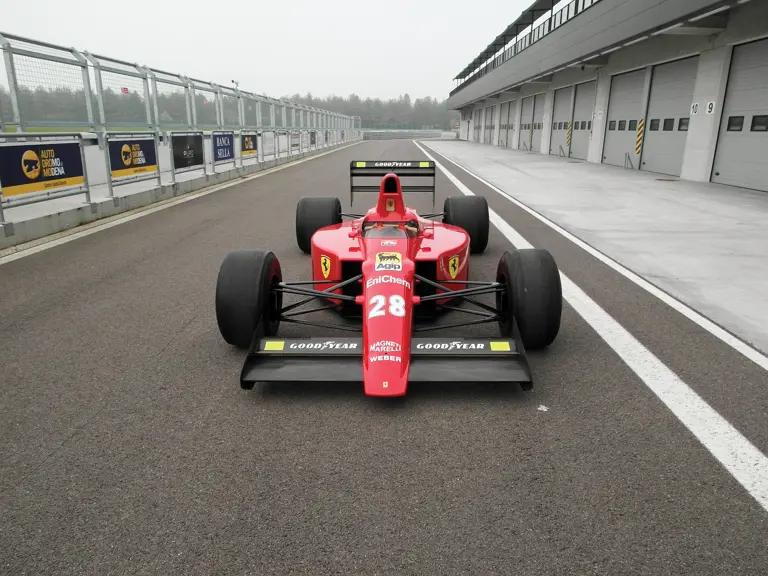
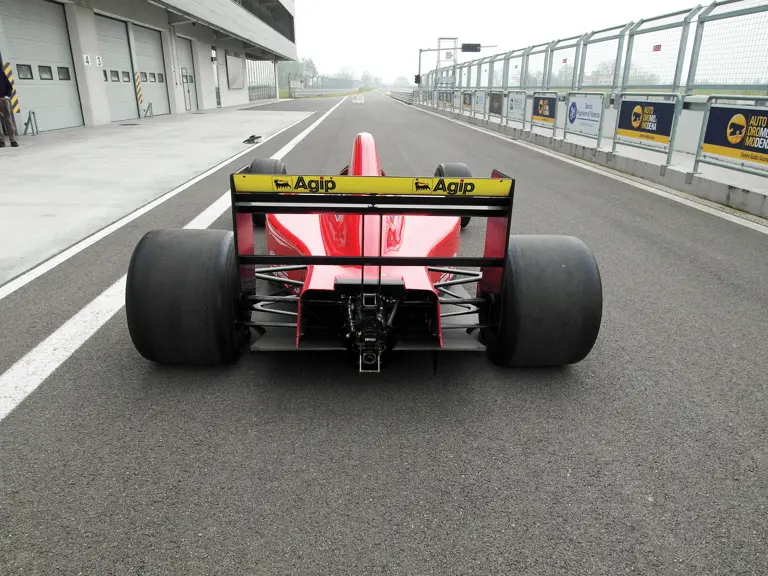
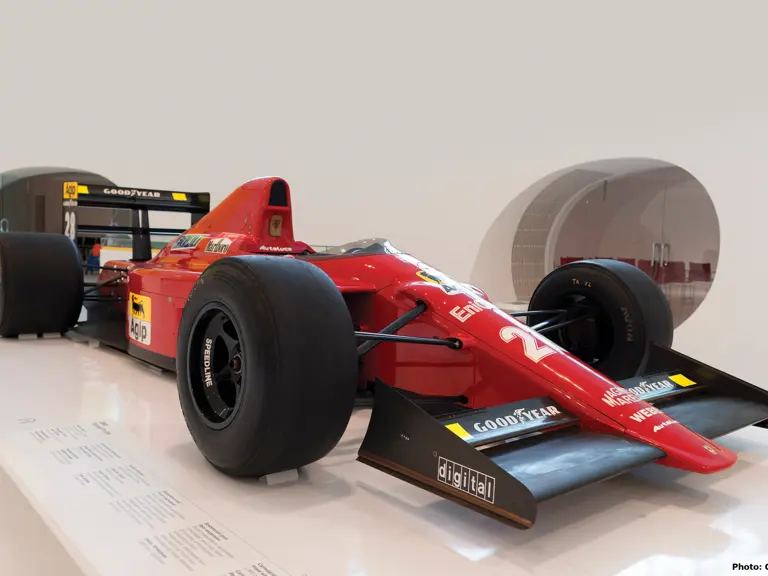
 | Monte Carlo, Monaco
| Monte Carlo, Monaco
